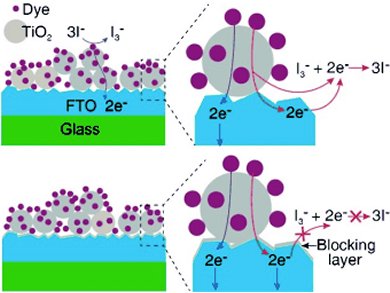The efficiency of dye-sensitized solar cells (DSSCs) is generally higher under low or moderate light intensities than that of conventional semiconductor photovoltaic devices. This makes them attractive for use indoors or under cloudy conditions. To maintain efficient charge generation under low light conditions, a blocking layer (BL) is essential. Often a thin insulating or semiconducting layer typically of TiO2 is used between the transparent conductive oxide and the mesoporous TiO2 to block electron/hole recombination at the conducting oxide/electrolyte interface.
Gregory N. Parsons, North Carolina State University, Raleigh, NC, USA, and colleagues show that atomic layer deposition (ALD) can produce ultrathin (<10 nm) BLs that significantly impede charge recombination in functional DSSCs. This leads to improved photocurrents, open-circuit photovoltages, and fill factors which results in an increase in the overall efficiency from ≈7% to ≈8.4% under AM 1.5G illumination (solar simulation spectrum). These ALD BLs are the thinnest optimized DSSC BLs reported to date.
By preparing BLs through other deposition techniques, the team demonstrate that ALD results in better performance, even with thinner films, which is ascribed to the lower pinhole density of ALD materials.
- Atomic Layer Deposition of High Performance Ultrathin TiO2 Blocking Layers for Dye-Sensitized Solar Cells,
D. H. Kim, M. Woodroof, K. Lee, G. N. Parsons,
ChemSus Chem 2013.
DOI: 10.1002/cssc.201300067




